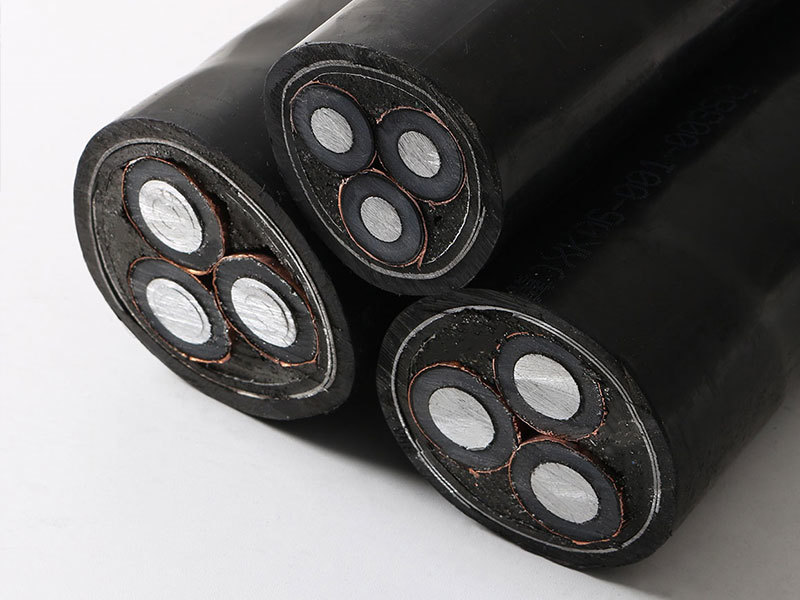Common faults and solutions of power cables

The method to determine the type of cable fault is to use an insulation resistance meter to measure the insulation resistance of each phase at one end of the line. Generally, the type of fault is determined based on the following situations:
(1) When the insulation resistance of one or several cores of a cable to ground or between cores is less than 100 kiloohms, it is a low resistance grounding or short circuit fault.
(2) When the insulation resistance of one or several cores of a cable to ground is measured by shaking, or when the insulation resistance between cores is much lower than the normal value but higher than 100 kiloohms, it is a high resistance grounding fault.
(3) When the insulation resistance of one or several cores of the shake test cable to ground is high or normal, a conductor continuity test should be conducted to check for wire breakage. If there is, it is a wire breakage fault.
(4) When one or several conductors of the shake test cable are discontinuous and grounded through a resistor, it is a broken wire and grounded fault.
(5) Flashover faults often occur during preventive voltage withstand tests, and the locations of occurrence are mostly at cable terminals and intermediate joints. Flashing sometimes occurs multiple times in a row, with intervals ranging from a few seconds to a few minutes between each occurrence.
Testing methods for faults
The instruments and equipment used in the past include QF1-A cable detector, DLG-1 flash tester, cable routing instrument, and fault locator. The most popular testing method currently is the flash test method, which includes flash and direct flash, with the most commonly used being the flash test method. The flash test has high accuracy, simple operation, and is safe and reliable. The equipment mainly consists of two parts, namely the high-voltage generator and the current pulse meter. High voltage generator is used to generate direct current high voltage or impulse high voltage, which is applied to the faulty cable to force the fault point to discharge and generate a reflected signal. Current pulse meter is used to pick up reflected signals to measure fault distance or directly measure open circuit, short circuit or low resistance faults with low-voltage pulses. Below is a brief description of the testing method based on the resistance at the fault point:
(1) When the resistance at the fault point is infinite, it is easy to find the open circuit fault using the low voltage pulse method for measurement. Generally speaking, pure open circuit faults are not commonly seen, and usually open circuit faults are high resistance faults between relative ground or phases, as well as low resistance faults between relative ground or phases.
(2) When the resistance at the fault point is equal to zero, it is easy to find a short circuit fault using the low-voltage pulse method, but this type of fault is rarely encountered in practical work.
(3) When the resistance of the fault point is greater than zero and less than 100 kiloohms, low resistance faults can be easily found by measuring with low voltage pulse method.
(4) Flashover faults can be measured using the direct flash method, which generally exists inside the joint. The resistance at the fault point is greater than 100 kiloohms, but the value varies greatly, and each measurement is uncertain.
(5) High resistance faults can be measured using the flash method, and the resistance at the fault point is greater than 100 kiloohms and the value is determined. Generally, when the test current is greater than 15 milliamps, the test waveforms have repeatability and can overlap, and each waveform has one emission, three reflections, and the pulse amplitude gradually decreases, the distance measured is the distance from the fault point to the cable testing end; Otherwise, it is the distance from the fault point to the opposite end of the cable test.
The improvement of cable fault testing technology level should adopt different methods for different fault properties, continuously introduce new technologies and equipment, and explore experience and develop new functions on new equipment. The testing technology for receiving signals at fault points using audio frequency signals to cables, as well as the precise positioning of fault points using the SDC series highly intelligent cable fault flash tester with T16/910 cable fault tester. These devices can control the measurement error within a few tens of centimeters, directly locate the fault point for processing, and improve the efficiency of fault detection.
TAG:
Next
Next:
Related Posts
Analysis of the meaning of the letters in overhead conductor models










